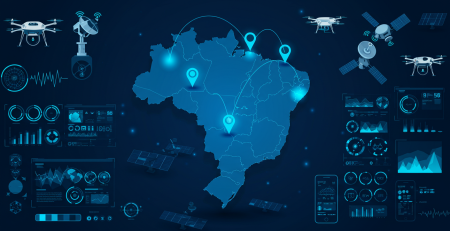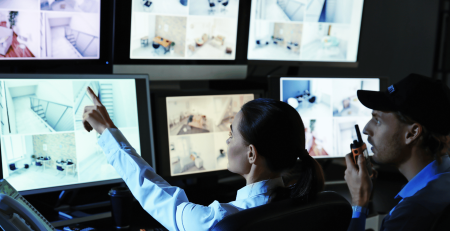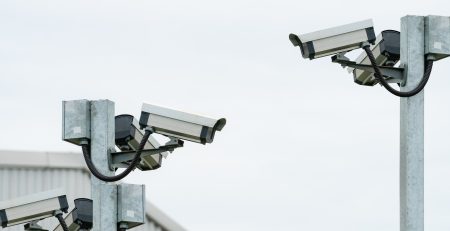CCTV and Facial Recognition in Public Spaces
Public safety is a priority for any community. With the advancement of technology, integrating CCTV (Closed Circuit Television) with facial recognition has become a powerful solution to improve surveillance in public spaces. Let's explore how this combination can transform security while ensuring compliance with legal regulations.
What is CCTV?
CCTV, or Closed Circuit Television, is a monitoring system that uses cameras to transmit signals to specific monitors. Unlike open TV, CCTV is a closed system, allowing only authorized users to access the images. Key components include cameras, monitors, video recorders, and network infrastructure.
Evolution of CCTV
CCTV has evolved significantly over the years. The first cameras were analog, with limited image quality. Today, digital cameras offer high definition images, night vision and motion detection, making CCTV an essential tool in public security.
What is Facial Recognition?
Facial recognition is a technology that identifies or verifies a person's identity using their face. It uses cameras to capture an image of the face, which is then compared to a database of images. Key components include cameras, recognition software and advanced algorithms.
Main Components
Cameras
Cameras used in facial recognition must have high resolution to capture accurate facial details.
Software
Facial recognition software processes the captured images and compares them with the images in the database.
Algorithms
Algorithms are responsible for analyzing facial features and determining a match.
Benefits of Integrating CCTV with Facial Recognition
Increased Security
Integrating CCTV with facial recognition significantly increases security in public spaces. The technology allows suspicious people to be identified quickly, alerting authorities for immediate action.
Identification Efficiency
Facial recognition is fast and accurate, allowing the identification of individuals in real time. This is particularly useful at large public events where security is a concern.
Crime Prevention
The presence of CCTV cameras with facial recognition deters criminal activities. Criminals are less likely to act in monitored areas, knowing they can be identified quickly.
Success Stories in Using CCTV with Facial Recognition
Pioneer Cities
Several cities around the world have already successfully implemented this technology. London, for example, uses CCTV with facial recognition to monitor high-risk areas, resulting in a significant reduction in crime rates.
Impact Statistics
Studies show that implementing CCTV with facial recognition can reduce crime by up to 30%. Furthermore, the crime solving rate increases due to the availability of clear visual evidence.
Implementation of CCTV with Facial Recognition
Needs Assessment
Before implementing, it is crucial to assess the specific needs of the location. Identify critical areas that need monitoring, such as entrances, exits and high-risk zones.
Choice of Equipment
Select high-quality cameras and reliable software. Make sure the equipment you choose meets your specific needs and offers advanced features such as night vision and motion detection.
Installation and Configuration
Installation must be carried out by qualified professionals. Ensure all cameras are positioned correctly and the system is configured to operate efficiently.
Compliance with Law 14,133/2021
Bidding Procedures
Law 14,133/2021 establishes clear guidelines for bidding on CCTV systems with facial recognition. Prepare a detailed notice and follow legal procedures to ensure transparent and fair hiring.
Supplier Selection Criteria
Select suppliers based on criteria such as equipment quality, market experience and technical support offered. Make sure the supplier you choose complies with legislation.
Challenges and Ethical Considerations
Privacy and Consent
The implementation of facial recognition raises privacy concerns. It is essential to ensure that citizens are aware of the use of technology and that their privacy rights are respected.
Transparency and Responsibility
Transparency is fundamental. Authorities must be clear about how the technology will be used and ensure there are accountability mechanisms in place.
Future of CCTV with Facial Recognition
Artificial intelligence
Artificial intelligence is continually improving facial recognition. With AI, it is possible to analyze large volumes of data in real time, increasing the accuracy and efficiency of the system.
New Applications
The future of facial recognition includes new applications, such as integration with access control systems and the automation of security processes.
Conclusion
Integrating CCTV with facial recognition is a powerful tool for improving public safety. With compliance with Law 14,133/2021, implementation becomes more transparent and effective. Investing in cutting-edge technology is essential to ensure safety in public spaces. If you are looking for integrated CCTV solutions, C2H Solutions is ready to help. Contact us through our contact page to receive a quote and improve the safety of your community.
FAQs
- What is CCTV?
- CCTV, or Closed Circuit Television, is a monitoring system that uses cameras to transmit signals to a specific set of monitors.
- How does facial recognition work?
- Facial recognition uses cameras to capture images of the face, which are compared to a database to identify or verify a person's identity.
- What are the benefits of CCTV with facial recognition?
- Increased security, efficiency in identifying and preventing crimes are some of the main benefits.
- How to ensure compliance with Law 14,133/2021?
- Following the bidding procedures established by law and choosing qualified suppliers are essential steps.
- What are the ethical challenges in implementing facial recognition?
- Guaranteeing citizens' privacy and maintaining transparency in the use of technology are important challenges.







Comments (12)
💡 A combinação de CFTV e reconhecimento facial é uma inovação poderosa para a segurança em espaços públicos, proporcionando mais proteção e agilidade nas respostas a incidentes. É uma solução que transforma a segurança urbana!
👉 Quer aprofundar seus conhecimentos sobre #Soluções Integradas de CFTV? Explore mais conteúdos exclusivos em nosso blog na seção #Soluções Integradas de CFTV.
🤝 Envie um email para nosso departamento comercial! comercial@c2hsolutions.com.br
💡 O uso de CFTV e reconhecimento facial em espaços públicos não só aumenta a segurança, mas também promove uma sensação de proteção na comunidade. Essa tecnologia inovadora está transformando a forma como interagimos com nosso ambiente!
👉 Quer aprofundar seus conhecimentos sobre #Soluções Integradas de CFTV? Explore mais conteúdos exclusivos em nosso blog na seção #Soluções Integradas de CFTV.
🤝 Envie um email para nosso departamento comercial! comercial@c2hsolutions.com.br
💡 O uso de CFTV e reconhecimento facial em espaços públicos não apenas melhora a segurança, mas também promove uma sensação de proteção coletiva. Essa tecnologia é um passo importante para cidades mais seguras!
👉 Quer aprofundar seus conhecimentos sobre #Soluções Integradas de CFTV? Explore mais conteúdos exclusivos em nosso blog na seção #Soluções Integradas de CFTV.
🤝 Envie um email para nosso departamento comercial! comercial@c2hsolutions.com.br
💡 A implementação de CFTV e reconhecimento facial em espaços públicos não apenas melhora a segurança, mas também promove uma sensação de proteção na comunidade. É fundamental discutirmos essas inovações para um futuro mais seguro!
👉 Quer aprofundar seus conhecimentos sobre #Soluções Integradas de CFTV? Explore mais conteúdos exclusivos em nosso blog na seção #Soluções Integradas de CFTV.
🤝 Envie um email para nosso departamento comercial! comercial@c2hsolutions.com.br
🔍 O uso de CFTV e reconhecimento facial em espaços públicos não apenas aumenta a segurança, mas também promove a confiança da comunidade. É uma inovação que transforma a forma como protegemos nossas cidades!
👉 Quer aprofundar seus conhecimentos sobre #Soluções Integradas de CFTV? Explore mais conteúdos exclusivos em nosso blog na seção #Soluções Integradas de CFTV.
🤝 Envie um email para nosso departamento comercial! comercial@c2hsolutions.com.br
💡 A implementação de CFTV com reconhecimento facial em espaços públicos não apenas aumenta a segurança, mas também proporciona um ambiente mais tranquilo para todos. É uma solução inovadora que traz confiança à comunidade!
👉 Quer aprofundar seus conhecimentos sobre #Soluções Integradas de CFTV? Explore mais conteúdos exclusivos em nosso blog na seção #Soluções Integradas de CFTV.
🤝 Envie um email para nosso departamento comercial! comercial@c2hsolutions.com.br
💡 O uso de CFTV e reconhecimento facial pode transformar a segurança em espaços públicos, aumentando a proteção e a eficiência na identificação de ameaças. 🌐 Não perca a oportunidade de conhecer as possibilidades que essas tecnologias oferecem!
👉 Quer aprofundar seus conhecimentos sobre #Soluções Integradas de CFTV? Explore mais conteúdos exclusivos em nosso blog na seção #Soluções Integradas de CFTV.
🤝 Envie um email para nosso departamento comercial! comercial@c2hsolutions.com.br
💡 A implementação de CFTV e reconhecimento facial em espaços públicos não só aumenta a segurança, mas também promove um ambiente mais seguro para todos. É fascinante ver como a tecnologia pode transformar nossas cidades!
👉 Quer aprofundar seus conhecimentos sobre #Soluções Integradas de CFTV? Explore mais conteúdos exclusivos em nosso blog na seção #Soluções Integradas de CFTV.
🤝 Envie um email para nosso departamento comercial! comercial@c2hsolutions.com.br
💡 O uso de CFTV e reconhecimento facial em espaços públicos não só aumenta a segurança, mas também promove um ambiente mais protegido para todos. A tecnologia é uma aliada na vigilância e na prevenção de crimes!
👉 Quer aprofundar seus conhecimentos sobre #Soluções Integradas de CFTV? Explore mais conteúdos exclusivos em nosso blog na seção #Soluções Integradas de CFTV.
🤝 Envie um email para nosso departamento comercial! comercial@c2hsolutions.com.br
💡 A segurança pública se transforma com a tecnologia de CFTV e reconhecimento facial, garantindo maior proteção e agilidade nas respostas. É fundamental estarmos por dentro das inovações que impactam nosso cotidiano!
👉 Quer aprofundar seus conhecimentos sobre #Soluções Integradas de CFTV? Explore mais conteúdos exclusivos em nosso blog na seção #Soluções Integradas de CFTV.
🤝 Envie um email para nosso departamento comercial! comercial@c2hsolutions.com.br
#Soluções Integradas de CFTVCFTV e Reconhecimento Facial em Espaços Públicos#Soluções Integradas de CFTVSegurança com Inovação e Confiabilidade – C2H Solutions
#Soluções Integradas de CFTVCFTV e Reconhecimento Facial em Espaços Públicos#Soluções Integradas de CFTVSegurança com Inovação e Confiabilidade – C2H Solutions